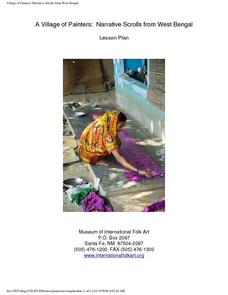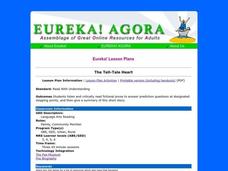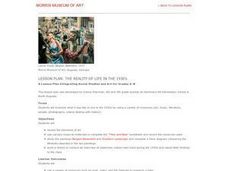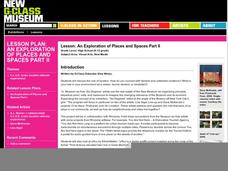Curated OER
Problem Solved!: Design Solutions
High schoolers learn about charrettes. In this arts lesson, students use creative problem solving processes used by design professionals and then investigate the role of problem solving in the world of design.
Curated OER
Creating a Textile Museum Piece from the Islamic Empire
Students create a drawing of an Islamic textile piece from the height of the Islamic Empire. Students describe the textile designs as symbolic representations of life in Islam during the 11th and 12th centuries.
Curated OER
A Village of Painters: Narrative Scrolls from West Bengal
Examine the process of making Indian patua-style narrative scrolls. Look closely at the images in the scrolls and have your young artists create an original patua painting. Using ink and watercolors, the class can illustrate their...
Curated OER
Image as Metaphor
A Dorothea Lange photograph launches this study of metaphors. Using the questions provided, the class examines the image and the title to consider how Lange uses her photo as a metaphor. Class members then select an object they can use...
Curated OER
The Tell-Tale Heart
Readers listen and critically read fictional prose to answer prediction questions at designated stopping points, and then they give a summary of the short story. This lesson is ideal for English language learners developing English...
Curated OER
Furniture Defined
Students dissect and evaluate traditional definitions of furniture styles. In this furniture characteristics lesson, student learn to classify different styles and types of furniture. Students create furniture sketches.
Curated OER
The Museum as a Time Capsule: Mongolian Example
Students make defensible inferences based on observation of perceived evidence. They use observation and inference to recognize the validity of alternative approaches or solutions.
Curated OER
Murals, Memories, and Making Art
Fourth graders examine the life and works of famous artists. Using the internet, they take notes and present their information to the class in an oral presentation. They create their own original artwork in the same style of their...
Curated OER
Looking at French Decorative Arts: The Quest for True Porcelain
Pupils study the effects of production and consumption of goods on French society during the porcelain period. For this history lesson students research the trade history of porcelain from Asia.
Curated OER
Curator's Report
Students write a curator's report in order to persuade a board of directors to purchase an artwork for a museum.
Curated OER
Critical Stance Lesson 1: Which Style Fits?
Students analyze the elements of style for a work of art and compare it with the elements of style for a piece of writing. They read selections of the same story, and select the writing style that best fits the style of the painting,
Curated OER
Objects of Adornment
Students identify adornments as a form of art. In this art and jewelry lesson, students view portraits of two historical princess noticing their adornments, then draw a person in their life focusing on the adornments they wear.
Curated OER
Virtual Ellis Island Museum Unit:
Students conduct secondary source research using the internet and library resources to research the backgrounds of their family's cultural and ethnic heritages.
Curated OER
Peking Opera Mask
Learners design and create their own masks using the symbolism evident in Peking opera masks.
Curated OER
The Reality of Life in the 1930s
Students examine the life style of the 1930's using art, music, the Internet and interviews as resources. They complete worksheets including a Venn diagram comparing two pieces of artwork. They determine what life during the Great...
Curated OER
Understanding Tenement Life
Students look at life for immigrants in the 19th century. In this immigrant lesson plan, students discuss how the poor German, Irish, Italian, and Jewish immigrants lived in tenement housing. They research the reasons they came to...
New Class Museum
Lesson: An Exploration of Places and Spaces Part II
How does your location alter or impede your movement? An interesting question posed by two artists, who work to show the restrictions of people in various landscapes. Learners analyze both exhibitions, discuss location and movement, then...
Roald Dahl
Matilda - The Third Miracle
Magnus takes a visit to the classroom in the 20th chapter of Matilda. Or does he? After reading, learners interview the person in the hot seat to get a detailed account of what happened during this chapter. Then, they write individual...
Roald Dahl
Matilda - The New Home
Matilda finally gets her happy ending with a new home with Miss Honey. But first, Mr. Wormwood goes on trial for his wrong doings and bad car sales. Class members take on the role of a character in the trial and participate in a role...
Roald Dahl
Matilda - Miss Trunchbull
How would you react to the Trunchbull if she was your teacher? This is the focus of an activity that has readers imagining and then acting out their reactions to various Trunchball scenarios in the story.
Roald Dahl
Matilda - The First Miracle
As the story unfolds, readers discover Matilda has a superpower. Take part in an activity that has learners talking about what superpower they would have, how they would use it, and how it could help others. Then, after reading the...
Museum of Disability
Taking Down Syndrome to School
Teach your class about the ways they can befriend and understand people who are different from them with a reading comprehension lesson. As youngsters read Taking Down Syndrome to School by Jenna Glatzer, they answer a...
University of Chicago
Comparing Modern and Ancient Ideas of Ethnicity and Identity
Explore ethnicity and identity with a research and writing assignment. Class members conduct online research, looking in particular at images and carefully noting down their sources on notecards. They read about identity and compose...
New Class Museum
Lesson: Elizabeth Peyton: Portraits: Androgyny in Contemporary Culture
Portraiture, artistic expression, romanticism, and androgyny are discussed in a thought-provoking activity. Upper graders first discuss and examine the history of portraiture and the elements common to the Romantic style. Then they turn...























